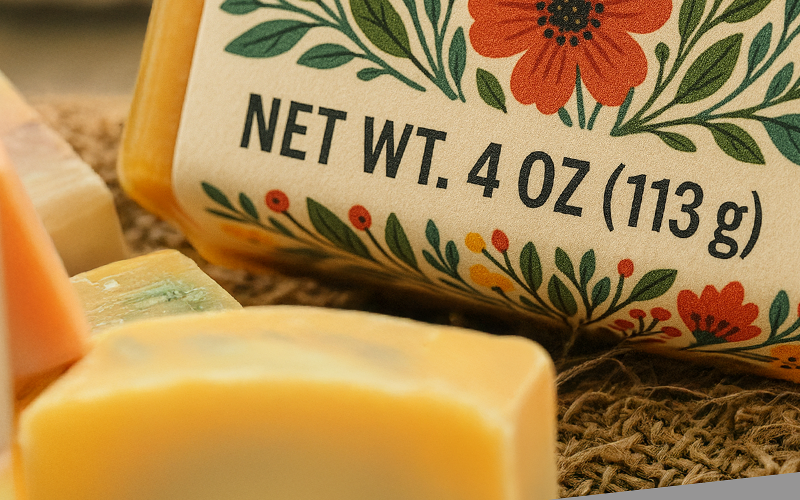One of the most common trouble spots on soap and cosmetic labels is the net contents declaration—that little line telling the consumer how much product is in the package. It seems simple, but the rules around type size, placement, and format can cause headaches—especially for anyone used to working with sleek design.
Let’s walk through the requirements and some practical tips to make sure your net contents are not just compliant, but also workable on your label.
Where the Net Contents Go
The law requires that the net contents appear on the front, lower 30% of the principal display panel (PDP)—that is, the part of the package most likely to be seen under normal conditions of sale.
- For jars and bottles, the PDP is the front-facing part of the label.
- For square containers (boxes or flat packages) or soap bars, it’s the entire front panel.
The net contents must be parallel to the bottom of the package. It can’t be tucked into a corner, curved along the edge, or turned sideways.
How Big Does the Text Need to Be?
This is where makers get caught off guard. The regulations tie type size directly to the area of the PDP, not the size of the package overall.
Here are the minimum requirements:
- PDP under 5 square inches → at least 1/16 inch high
- PDP 5–25 square inches → at least 1/8 inch high
- PDP 25–100 square inches → at least 3/16 inch high
All Caps vs. Mixed Case
The rule for measuring type size depends on how the words are written:
- Upper and lower case → size is measured by the height of the lowercase “o.”
- All capital letters → size is measured by the height of a capital letter.
This distinction matters. Because capital letters are taller than lowercase letters, using all caps actually results in a smaller overall font size requirement than mixed case.

Another trick: choosing a condensed font style reduces the width of the line while still keeping the required height. That can help the net contents fit neatly into your design.

Approximate Font Sizes
| PDP Size | Text Size | Font Size – Upper/Lower | Font Size – All CAPS |
| less than 5 sq. in | 1/16 in | 8 pt | 6 pt |
| 5 – 25 sq. in | 1/8 in | 18 pt | 12 pt |
| 25 – 100 sq. in. | 3/16 in | 24 pt | 18 pt |
Keep in mind: these are approximations (based on Arial font). The only thing that matters legally is the measured height of the letters on the printed label.
Why It Looks So Big (and Why Designers Hate It)
When you size the net contents according to the regulations, it often looks huge compared to the rest of the text on the label. Graphic designers—used to tiny, tasteful typography—may protest that it throws off the balance.
But remember: the point of the regulation is consumer clarity, not aesthetics. Lawmakers wanted the net contents to be immediately visible, without squinting or guessing.
Think of it as similar to nutrition facts or drug facts panels—required elements aren’t there to be pretty; they’re there to be obvious.
Tips to Make It Work
If you’re struggling to fit the net contents without wrecking your design, here are some tricks:
- Shorten the line – Use standard abbreviations like “Net Wt.” instead of “Net Weight.”
- Use condensed fonts – They take up less horizontal space while meeting the required height.
- Use a utilitarian font – Instead of using your designer font, use a basic font to remove it from your graphic design.
Special Cases
There are a few special cases for the net contents which have slightly different requirements not covered in this article:
- Large package, small label (i.e. gift basket or set)
- Small product attached to a card (i.e. lip balm)
- Decorative bottle (i.e. perfume bottle)
- Hang tag (i.e. bag or wrapper)
- Multiple products in one package
Final Thoughts
Getting the net contents declaration right is one of those “non-negotiables” in labeling. It has to be in the right place, in the right size, and easy to read. Yes, it may look bigger than you’d like, and yes, your designer may roll their eyes. But in the end, it’s one of the clearest ways to show customers exactly what they’re getting—and it keeps you compliant with the law.


Leave a Reply